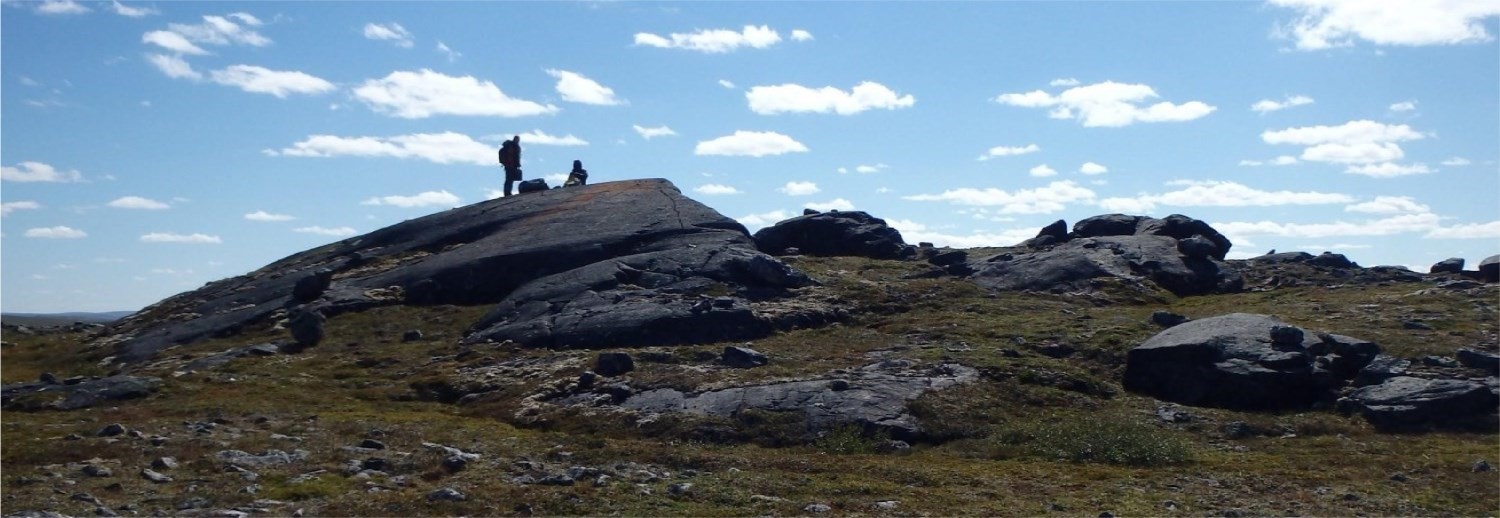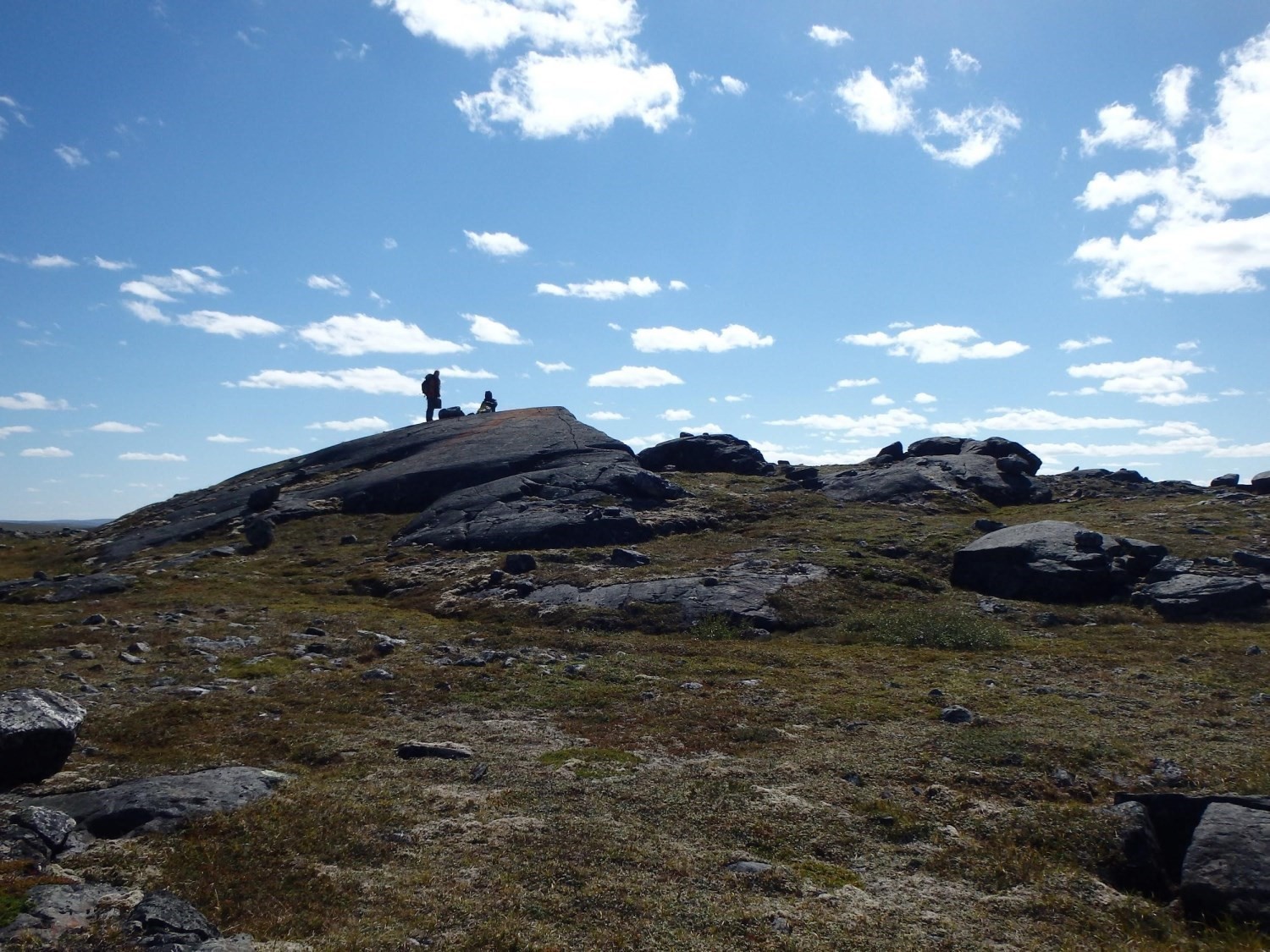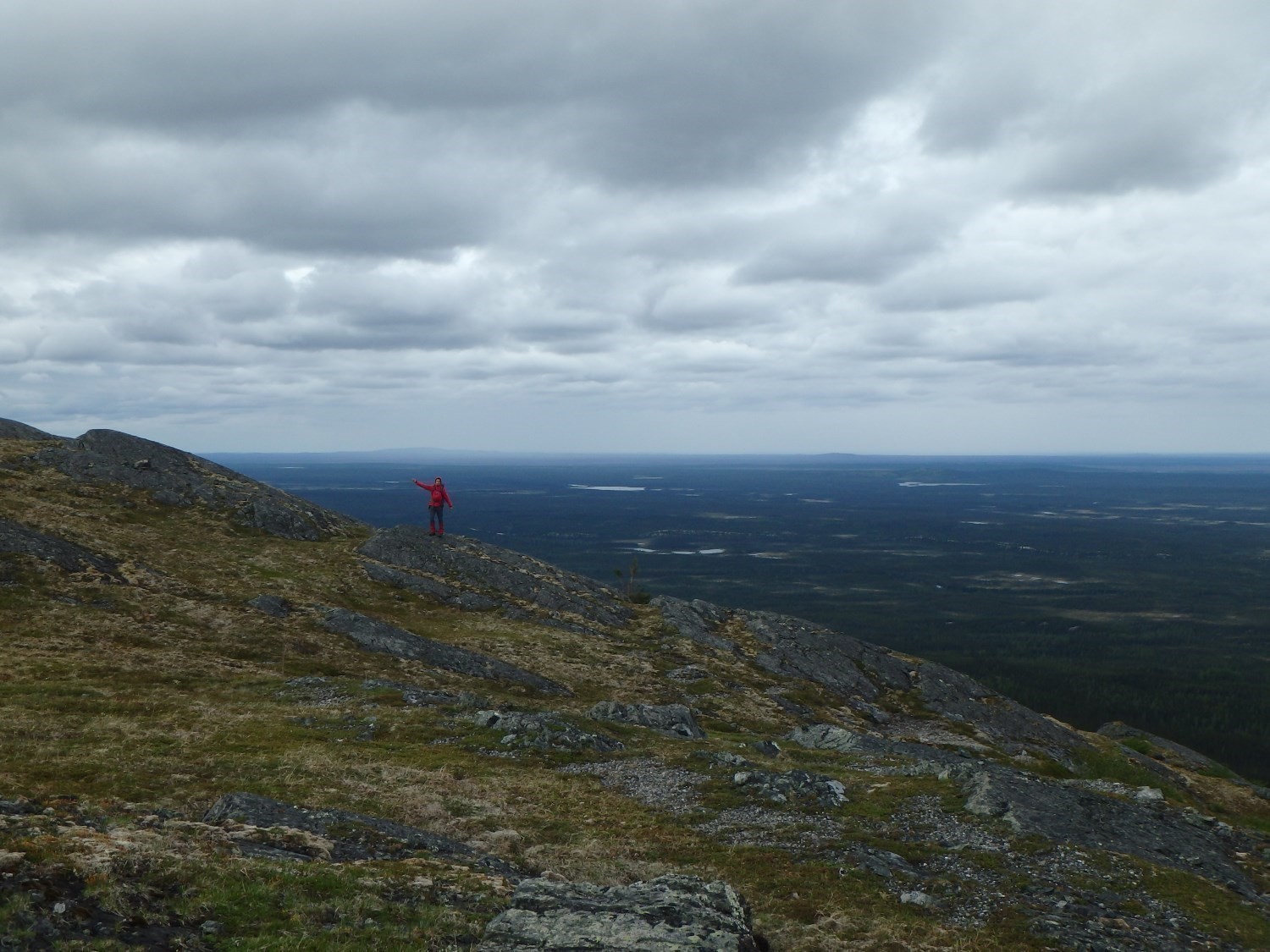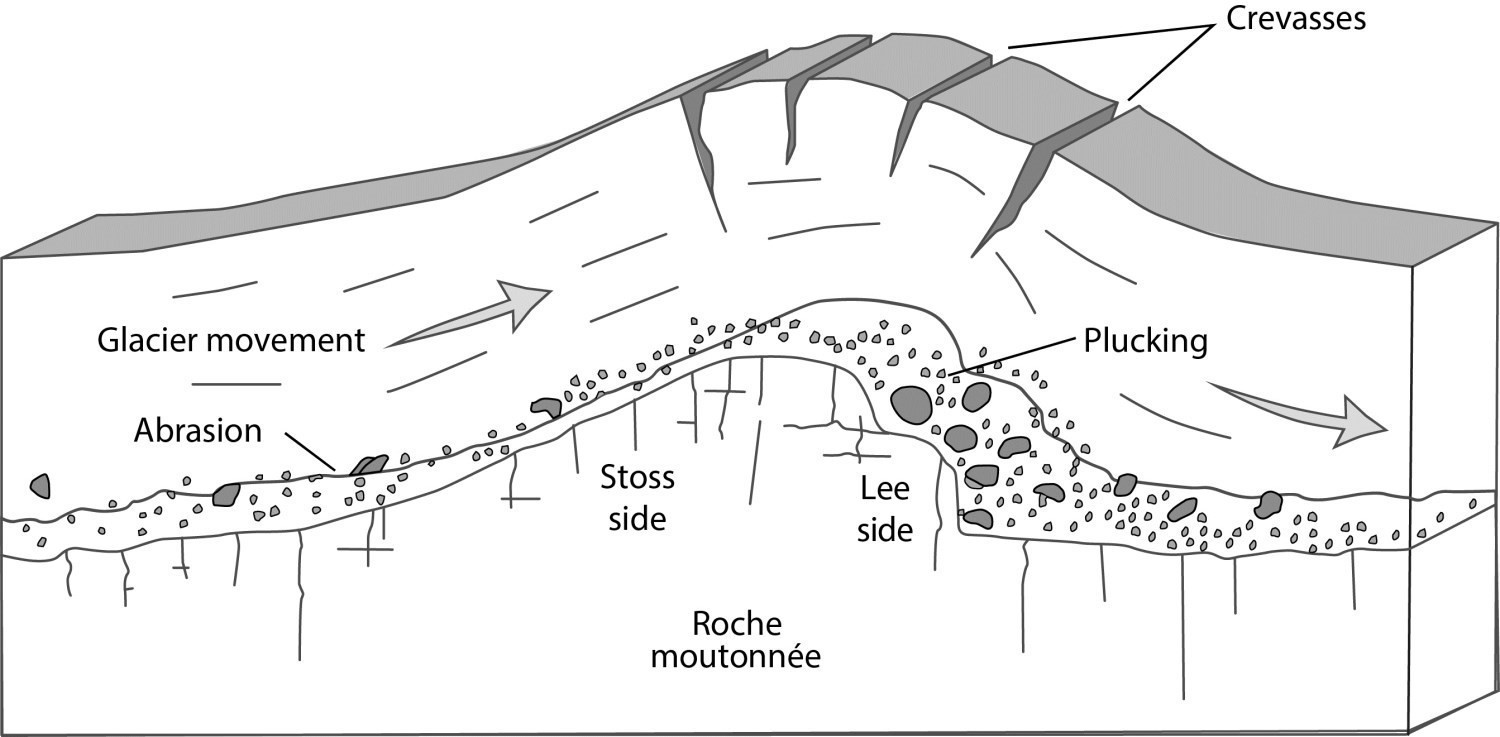
Last modification:
Etymology
The term “roche moutonnée” was introduced by French geologist Horace-Bénédict de Saussure (1740-1799). The origin of the word lies in its resemblance to the shape of a wig worn by 18th century French aristocrats whose hair was shaped like a wave. Sheep fat was used to hold the wig in place, thus explaining the term moutonné (Benn and Evans, 2010). In Sweden, very large roches moutonnées are called flyggbergs, some being up to 3 km long and 350 m wide (Rudberg, 1954; 1973; Iverson et al., 1995; Benn and Evans, 2010).
Description


 Roches moutonnées are asymmetrical rock outcrops characterized by a gently sloping up-ice side with a polished surface (stoss), and a down-ice side with a steeply sloping plucking surface (lee). Generally, they are a few metres in length and width. In some cases, they are several kilometres long and tens of metres wide (Glasser, 2002; Benn and Evans, 2010).
Roches moutonnées are asymmetrical rock outcrops characterized by a gently sloping up-ice side with a polished surface (stoss), and a down-ice side with a steeply sloping plucking surface (lee). Generally, they are a few metres in length and width. In some cases, they are several kilometres long and tens of metres wide (Glasser, 2002; Benn and Evans, 2010).
The up-ice surface of roches moutonnées is usually striated and grooved, reflecting the pressure exerted on the rock surface by the glacier (Seppälä and Rastas, 1980; Glasser and Warren, 1990). The geometry of the rock allows determining general ice flow direction, from up-ice (gentle slope) to down-ice (steep slope).
Genesis
Roches moutonnées are products of glacial erosion and explained by the presence of an obstacle creating a constraint to the ice flow (irregularity of bedrock topography). The two main erosional processes that produce roches moutonnées are abrasion on the surface up-ice and the plucking of rock fragments down ice. The plucking process is responsible for the erosion of a larger volume of rock than the abrasion process (Jahns, 1943; Boulton and Jones, 1979; Cohen et al., 2006). It is dependent on the orientation of joint and fracture systems, which is intrinsic to the bedrock structure (Glasser and Warren, 1990; Sugden et al., 1992).
Once the glacier comes in contact with a rocky obstacle, a succession of processes leads to the formation of roches moutonnées:
- Increase in cryoclastic pressure at the point of contact with the obstacle. Particles move towards the footwall and increase abrasion (Boulton et al., 1974; Glasser and Warren, 1981), causing the formation of striations and grooves. The increase in cryostatic pressure lowers the melting temperature of the ice, leading to partial melting at the base;
- Naturally flowing towards low-pressure zones, water bypasses the obstacle down ice;
- A low-pressure zone (cavity) is present down ice of the obstacle, causing an increase in melting temperature so that the water refreezes in rock fractures. Also, the low pressure allows new fractures to form (Carol, 1947; Iverson, 1991; Hallet, 1996). As water seeps into cracks, it causes rock fragments to break off, creating a plucking face.
Cavity formation plays a major role in the formation of roches moutonnées. Cavities and, by extension, roches moutonnées preferentially develop in temperate, thin-glacier regions, in marginal positions and where meltwater is abundant (Sugden et al., 1992; Roberts and Long, 2005; Benn and Evans, 2010). The presence of striations suggests warm-based glacial dynamics and a basal deformation flow mode.
It has been suggested that roches moutonnées are preglacial in origin (Lindström, 1988; Patterson and Boerboom, 1999) and that the fluvioglacial processes of Carol (1947) presented above merely accentuated pre-existing bedforms. Although these models are consistent, the ubiquity of roches moutonnées must be explained by a simple process that can occur anywhere. According to Boulton (1982), the difference in up-ice/down-ice pressure alone would be sufficient to cause the formation of fractures on rock reliefs in subglacial conditions.
Spatial Distribution
Roches moutonnées are ubiquitous bedforms that are, in Quebec, listed in almost all regional works dealing with Quaternary geology. Roches moutonnées are generally concentrated in areas of competent bedrock such as granitoids (Glasser, 2002).
Synonyms
Sheepback rock, sheep rock, embossed rock, mounded rock, glaciated rock knoll.
References
BENN, D.I., EVANS, D.J.A., 2010. Glaciers and glaciations, second edition. Routledge, Taylor & Francis Group, London and New York, 802 pages. doi.org/10.4324/9780203785010
BOULTON, G.S., DENT, D.L., MORRIS, E.M., 1974. Subglacial Shearing and Crushing, and the Role of Water Pressures in Tills from South-East Iceland. Geografiska Annaler. Series A, Physical Geography; volume 56, pages 135-145. doi.org/10.1080/04353676.1974.11879895
BOULTON, G.S., JONES, A.S., 1979. Stability of temperate ice caps and ice sheets resting on beds of deformable sediment. Journal of Glaciology; volume 24, pages 29-43. doi.org/10.3189/S0022143000014623
BOULTON, G.S., 1982. Processes and Patterns of Glacial Erosion. In Coates, D.R. (Éd.), Glacial Geomorphology. Fifth Annual Geomorphology Symposia Series, Binghamton, New York, Springer, pages 41-87. Source
CAROL, H., 1947. The formation of roches moutonnées. Journal of Glaciology; volume 1, pages 57-59. doi.org/10.3189/S0022143000007589
COHEN, D., HOOYER, T.S.S., IVERSON, N.R., THOMASON, J.F.F., JACKSON, M., 2006. Role of transient water pressure in quarrying: A subglacial experiment using acoustic emissions. Journal of Geophysical Research: Earth Surface; volume 111, pages 1-13. doi.org/10.1029/2005JF000439
GLASSER, N.F., 2002. The large roches moutonnées of upper Deeside. Scottish Geographical Journal; volume 118, pages 129-38. doi.org/10.1080/00369220218737141
GLASSER, N.F., WARREN, C.R., 1990. Medium scale landforms of glacial erosion in South Greenland; process and form. Geografiska Annaler. Series A, Physical Geography; volume 72, pages 211-215. doi.org/10.2307/521149
HALLET, B., 1996. Glacial quarrying: a simple theoretical model. Annals of Glaciology; volume 22, pages 1-8. doi.org/10.3189/1996AoG22-1-1-8
IVERSON, N.R., 1991. Potential effects of subglacial water-pressure fluctuations on quarrying. Journal of Glaciology; volume 37, pages 27-36. doi.org/10.3189/S0022143000042763
IVERSON, N.R., HANSON, B., HOOKE, R.L.B., JANSSON, P., 1995. Flow mechanism of glaciers on soft beds. Science; volume 267, pages 80-81. doi.org/10.1126/science.267.5194.80
JAHNS, R.H., 1943. Sheet structure in granites: Its origin and use as a measure of glacial erosion in New England. The Journal of Geology; volume 51, pages 71-98. doi.org/10.1086/625130
LINDSTRÖM, E., 1988. Are roches moutonnées mainly preglacial forms? Geografiska Annaler. Series A, Physical Geography; volume 70, pages 323-331. doi.org/10.1080/04353676.1988.11880263
PATTERSON, C.J., BOERBOOM, T.J., 1999. The significance of pre-existing, deeply weathered crystalline rock in interpreting the effects of glaciation in the Minnesota River valley, U.S.A. Annals of Glaciology; volume 28, pages 53-58. doi.org/10.3189/172756499781821995
ROBERTS, D.H., LONG, A.J., 2005. Streamlined bedrock terrain and fast ice flow, Jakobshavns Isbrae, West Greenland: implications for ice stream and ice sheet dynamics. Boreas; volume 34, pages 25-24. doi.org/10.1111/j.1502-3885.2005.tb01002.x
RUDBERG, S., 1954. Västerbottens berggrundsmorfologi. Ett försök till rekonstruktion av preglaciala crosionsgenerationer i Sverige. Geographica; volume 25, 457 pages.
RUDBERG, S., 1973. Glacial erosion forms of medium size – A discussion based on four swedish case studies. Zeitschrift für Geomorphologie; volume 17, pages 33-48. schweizerbart.de/publications/detail/isbn/9783443210175/Z_Geomorph_S_Bd_17
SEPPÄLÄ, M., RASTAS, J., 1980. Vegetation map of northernmost Finland with special reference to subarctic forest limits and natural hazards. Fennia; volume 158, pages 41-61. fennia.journal.fi/article/view/9174
SUGDEN, D.E., GLASSER, N.F., CLAPPERTON, C.M.M., 1992. Evolution of large roches moutonnees. Geografiska Annaler. Series A, Physical Geography; volume 74, pages 253-264. doi.org/10.1080/04353676.1992.11880368
Contributors
First publication | Olivier Lamarche, P. Geo., M.Sc. olivier.lamarche@mern.gouv.qc.ca (redaction); Hugo Raymond, GIT, B.Sc (redaction) Hugo Dubé-Loubert, P. Geo., Ph.D. (critical review); François Leclerc, P. Geo., Ph.D. (template and content compliance); Simon Auclair, P. Geo., M.Sc. (editing); Céline Dupuis, P. Geo., Ph.D. (English version); André Tremblay (HTML editing). |

